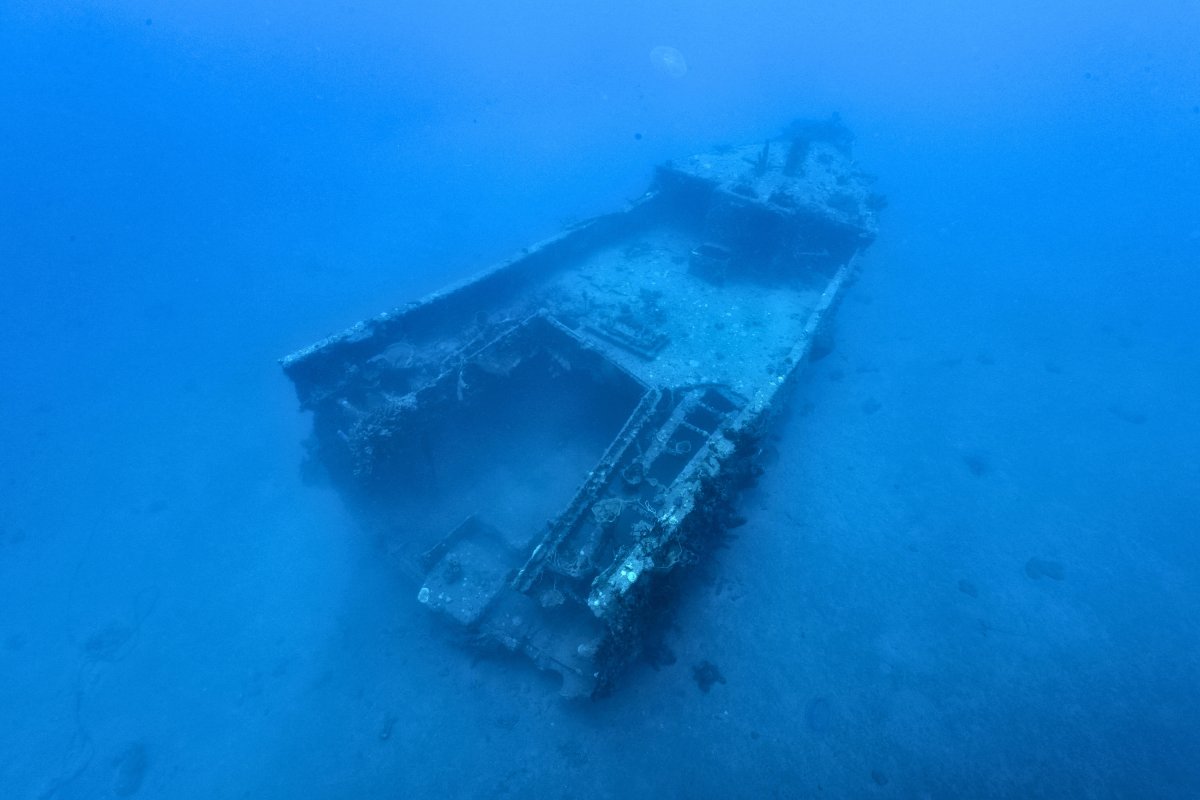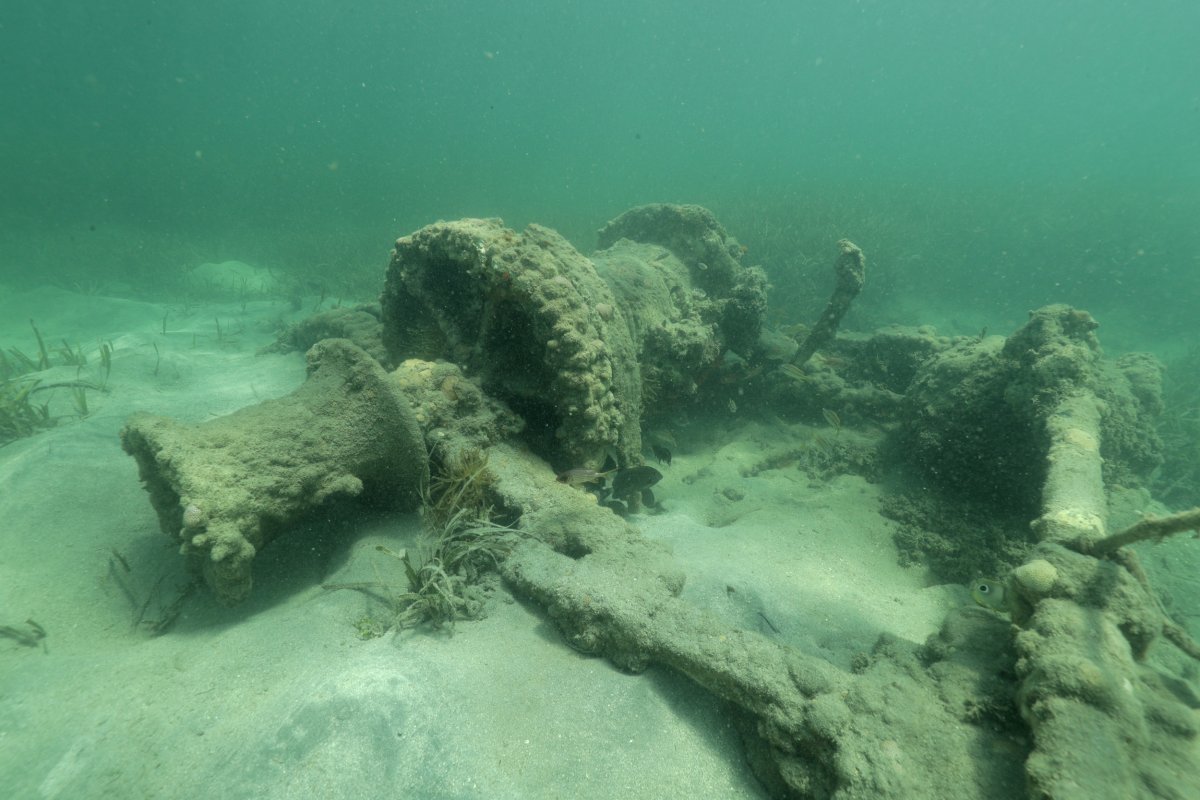I'm a treasure hunter by trade. I normally hunt shipwrecks of the early colonial period.
Back when I was 19, I was with my dad hunting shipwrecks in the Caribbean. As we ventured into international waters, we got into an argument, so I left the boat to go diving, just to get away from the pressure.
Listen to the episode:
It was while spearfishing that I lost my sling, and it landed on a metal boat below me. I swam down and when I saw it, I went: Oh my god, what the heck is that?
I'd never seen anything that large before. It was so big and ominous. I didn't know what it was or how it had gotten tucked under a cave. I thought it was perhaps a sunken freighter.
I went back to the boat and tried to tell my father what I found, but he said we weren't out looking for anything modern, we wanted early colonial period shipwrecks. I didn't want to deal with an argument, so I flew back to my mom in California.
Two weeks later, I came back to my dad. He told me: "That thing you saw, you're not gonna believe this—it's not a freighter, it's a German U-boat."

That discovery always stayed with me. We had to leave the area because my dad got into hot water with the Turks and Caicos Islands government. We returned to the U.S. and my dad never revisited. He stopped treasure hunting, and I took a break from it.
Later on in life, I started treasure hunting on my own again. I was always curious about that particular area, until one day I was on a treasure hunt in international waters close to where I remembered being.
We dove down there and I found remnants of a U-boat, including a pull rod from a torpedo shaft and a speaker from a radio with a plaque written in German saying it was made by "Siemens Apparate u. Maschinen", a German engineering company during WWII, dated 1940.
It was the evidence that I needed, and it sparked my enthusiasm for this project again. So I went out and pitched the story here and there, and it resulted in my fantastic new HISTORY Channel show: Lost U-Boats of WWII.
A historian friend connected me with a gentleman whose father hunted U-boats during the war. His father had handed down a chart when he passed away. It contained coordinates for suspected U-boats in the Caribbean that he had transposed from a U.S. government chart when he retired.
I don't know whether he planned to go back or not, but the chart ended up via my friend in my possession. So now I had this new chart with seven locations near the Dominican Republic, plus the evidence I discovered while diving.
What's more, my dad and I went to East Berlin in 1983. Once there we met with former Nazi U-boat commanders and came into possession of blueprints that suggested several U-boats were modified with their torpedoes removed.
Why would you remove your defense measures unless you needed the space to store and transport something valuable?
With all these pieces of evidence acquired over the years, giving information on potential vessel locations, I decided to take a break from my normal job as a treasure hunter for colonial shipwrecks and start putting some effort towards this U-boat project.
I was all in. I put together a crew— including my best friend and fellow treasure hunter Steve Bender, and the fantastic archaeologist and former Marine Garth Baldwin—and here we are with our HISTORY Channel show.
We found lots of amazing evidence along the way, some of it mind-blowing.

At the beginning of this journey, I wasn't a true believer. I never knew if my dad was exaggerating or not. I think scientifically; I need to see proof. Having found the speaker, I became a believer. But still, I hadn't found a U-boat—just pieces of it.
So I wanted to set this investigation up, but I wasn't quite ready until I received that U.S. naval chart.
In the show, we explain to the audience the insurmountable number of U-boats that were around the Caribbean during the war, all the way up the Atlantic Coast surrounding the U.S. territorial waters, and inside the Gulf of Mexico.
I'm old enough to have studied all of that and it's what I do; I love history. But I've never heard of anything like this. I did not know how many U-boats were in the Caribbean from 1941 to 1945. They were there to destroy merchant ships sending oil and petroleum from South America to Europe and the U.S.
Every little piece of evidence that we find opens another door, and the door tells us there are 10 more doors to walk in. We're just putting it together piece by piece.
We find out about this sleepy little village in the Dominican Republic, Montecristi, near the U-boat site that we visit, and find evidence that the Germans have been there since the late 1800s. It was a safe haven for Germans, and then later Nazis, because they had an enclave there.
And we know that the Nazis were trying to transport loot—be it jewelry, art, gold, or other treasures of high value that they stole—and have evidence to believe they had specially outfitted U-boats for this purpose.
We believe this area was a safe place for them to refuel and a meeting point to make their clandestine plans. It was a halfway point between the U.S. and South America.
It was a perfect hideaway, and I believe now that they planned to move down to South America. So I now also want to head down to South America given some of the clues that we found pointing us in that direction.
What surprised me most wasn't the evidence or Nazi artifacts we found. It was the people we were able to meet along the way. I met with a 98-year-old gentleman in one town who is the only living witness to a Nazi U-boat commander.
It blew my mind to hear his verbal testimony about having worked with this ex-commander at a marketplace without knowing about his Nazi past. The gentleman had also seen a U-boat right there in this town. I did not know that before we went to investigate the waters.
There are so many more chapters to this story, but we only have six episodes. There's so much more to this; I can't even imagine how much more work I have ahead of me. But good work. The clues are amazing. And we weren't able to finish our investigation.

The audience is going to be fascinated because ours is a WWII story that's never been told.
In 1942, U-boats almost destroyed the entire supply chain to the Allied forces in Europe and the U.S. They were that close. Luckily, the U.S and the Allies were able to prevent that.
But I still think the Nazis ended up getting away with whatever was on those U-boats. The evidence tells us that. I think I know where they went, too.
There is evidence these boats were towing things. There may have been a towing device. It could have been loot or arms, or both. We don't know what they were towing yet.
It's a fascinating and unfinished story. Our investigation was thrilling and it's changed my trajectory in life. I will always be a treasure hunter. I am a treasure hunter by heart. But now I'm so captivated by this story and uncovering secrets about WWII and the Nazis.
I just can't explain how amazing it was to dive down and be the first ones to touch actual artifacts that we know belonged to Nazis.
But this is not, for me, about the gold or treasure. Even if we discover a lot of treasure and stolen artifacts, I could never keep it. My crew and I agreed we would give it back to the rightful owners.
I'm certain all the people watching this show are going to come away surprised by the volume of evidence we come up with to show the proliferation of Nazi U-boats in that area. It was beyond anybody's imagination—over 700 U-boats.
It's an amazing story and I'm not just saying that. I don't get shocked very often because I've found lots of treasure in my life. I've been very fortunate to be successful in a business where success is extremely hard.
But I've never had this excitement that I have now.
I'm blown away and I hope everybody else is going to be too. It's a beautiful story to tell, and I hope to continue telling it because there's so much more. We've only just begun.
Darrell Miklos is a treasure hunter. His new HISTORY Channel series "Lost U-Boats of WWII" premieres on February 27 at 10pm ET/PT. The six-episode series will stream the next day on history.com, The HISTORY Channel app and across major television providers' VOD platforms.
All views expressed are the author's own.
As told to Shane Croucher.
Do you have a unique experience or personal story to share? Email the My Turn team at myturn@newsweek.com.
Uncommon Knowledge
Newsweek is committed to challenging conventional wisdom and finding connections in the search for common ground.
Newsweek is committed to challenging conventional wisdom and finding connections in the search for common ground.
About the writer
Darrell Miklos is a treasure hunter.
To read how Newsweek uses AI as a newsroom tool, Click here.






